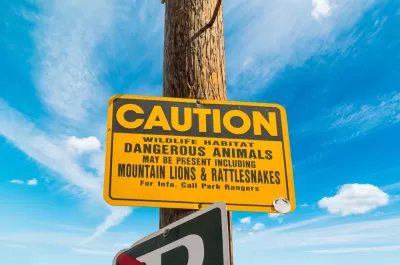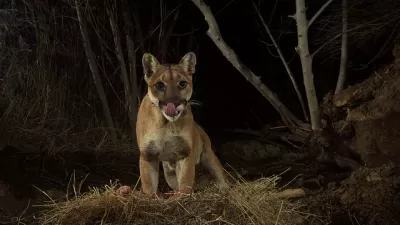The Los Angeles City Planning Commission recently approved a new Wildlife Ordinance. The City Council will make the final decision about the ordinance’s approval.

The Los Angeles City Planning Commission (CPC) approved a new Wildlife Ordinance earlier this month, according to an email to Planetizen from the Los Angeles Department of City Planning.
The draft ordinance proposes development standards for lot coverage, floor area, grading, and height limitations, and as well as native landscaping/trees, fence, trash enclosure, window and lighting requirements, according to the email. The draft ordinance makes the case that these zoning changes are necessary to fight climate change and protect biodiversity. The new zoning rules would be implemented in a new Wildlife Supplemental Use District (WLD) added to the city’s zoning map by the ordinance.
The Los Angeles Daily News covered the Wildlife Ordinance over the summer, while the current version of the ordinance was open for public comment. “The proposed Wildlife District would directly impact hilly communities in the Hollywood Hills, Hollywood, Bel Air, Beverly Crest, Laurel Canyon, Sherman Oaks and Studio City. The southern border of the proposed district follows a stair-stepping line just north of Franklin Avenue, Hollywood Boulevard, Sunset Boulevard and smaller streets in Beverly Hills,” according to that article. The Los Angeles Times Editorial Board also chimed in on the issue in November, supporting the idea of making space for animals and biodiversity in the residential neighborhoods of Los Angeles adjacent to wild and open spaces.
The vote came just a few days before the death of P-22, the city’s fabled mountain lion resident, credited with birthing and building a wildlife protection movement in the nation’s second most populous city. Alissa Walker has written an article describing the tragic and compelling story of P-22’s life in the wild parts of Los Angeles.
The CPC vote brings a planning process launched in 2016 with the Wildlife Pilot Study a critical step closer to completion. The Los Angeles City Council must still approve the ordinance for adoption.
FULL STORY: Wildlife Pilot Study

Planetizen Federal Action Tracker
A weekly monitor of how Trump’s orders and actions are impacting planners and planning in America.

Maui's Vacation Rental Debate Turns Ugly
Verbal attacks, misinformation campaigns and fistfights plague a high-stakes debate to convert thousands of vacation rentals into long-term housing.

Restaurant Patios Were a Pandemic Win — Why Were They so Hard to Keep?
Social distancing requirements and changes in travel patterns prompted cities to pilot new uses for street and sidewalk space. Then it got complicated.

In California Battle of Housing vs. Environment, Housing Just Won
A new state law significantly limits the power of CEQA, an environmental review law that served as a powerful tool for blocking new development.

Boulder Eliminates Parking Minimums Citywide
Officials estimate the cost of building a single underground parking space at up to $100,000.

Orange County, Florida Adopts Largest US “Sprawl Repair” Code
The ‘Orange Code’ seeks to rectify decades of sprawl-inducing, car-oriented development.
Urban Design for Planners 1: Software Tools
This six-course series explores essential urban design concepts using open source software and equips planners with the tools they need to participate fully in the urban design process.
Planning for Universal Design
Learn the tools for implementing Universal Design in planning regulations.
Heyer Gruel & Associates PA
JM Goldson LLC
Custer County Colorado
City of Camden Redevelopment Agency
City of Astoria
Transportation Research & Education Center (TREC) at Portland State University
Jefferson Parish Government
Camden Redevelopment Agency
City of Claremont





























